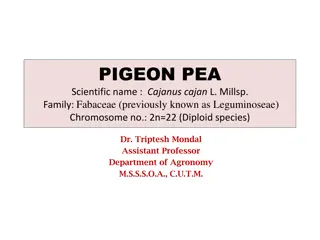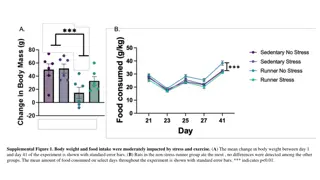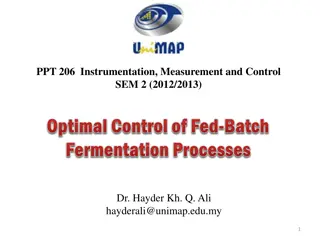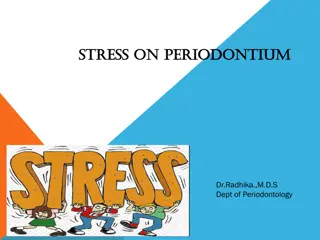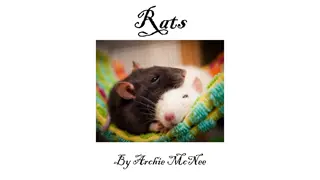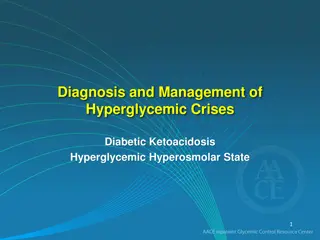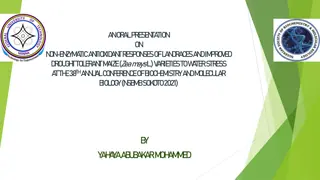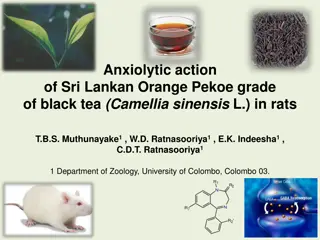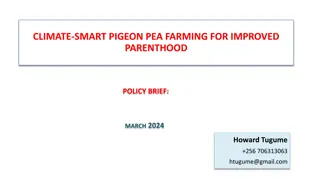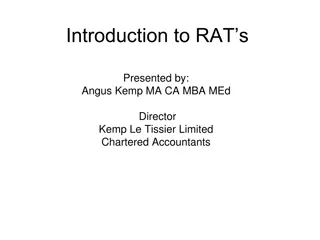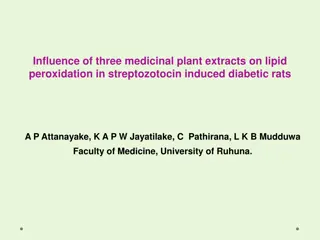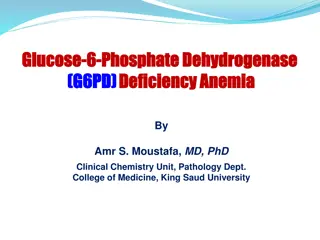Impact of Natural Antioxidant on Reducing Oxidative Stress in Hyperglycemic Rats Fed Germinated Pigeon Pea Diet
Diabetes, a metabolic disorder characterized by hyperglycemia, affects millions worldwide. Oxidative stress plays a key role in its pathogenesis, leading to decreased antioxidant capacity. This study explores the potential of natural antioxidants from germinated pigeon pea to reduce oxidative stress in hyperglycemic rats, offering insights into their impact on blood glucose levels, lipid peroxidation, and liver tissue health.
Download Presentation

Please find below an Image/Link to download the presentation.
The content on the website is provided AS IS for your information and personal use only. It may not be sold, licensed, or shared on other websites without obtaining consent from the author.If you encounter any issues during the download, it is possible that the publisher has removed the file from their server.
You are allowed to download the files provided on this website for personal or commercial use, subject to the condition that they are used lawfully. All files are the property of their respective owners.
The content on the website is provided AS IS for your information and personal use only. It may not be sold, licensed, or shared on other websites without obtaining consent from the author.
E N D
Presentation Transcript
IMPACT OF NATUAL ANTIOXIDANT IMPACT OF NATUAL ANTIOXIDANT ON REDUCTION OF OXIDATIVE ON REDUCTION OF OXIDATIVE STRESS IN HYPERGLYCEMIC RAT STRESS IN HYPERGLYCEMIC RAT FED GERMINATED PIGEON PEA DIET FED GERMINATED PIGEON PEA DIET UCHEGBU NNEKA NKECHI DEPARTMENT OF FOOD TECHNOLOGY INSTITUTE OF MANAGEMENT AND TECHNOLOGY, ENUGU STATE, NIGERIA uchegbu.nneka@yahoo.com
INTRODUCTION Diabetes affects different people of all ages, race and sex. It is estimated that worldwide there are approximately 150 million people with diabetes mellitus. Diabetes is a metabolic disorder characterized by hyperglycemia and insufficient secretion or action of endogenous insulins. Oxidative stress plays a major role in the pathogenesis of diabetes. oxidative stress is accompanied by a decreased antioxidantcapacity. This increased
INTRODUCTION (Cont.) Usage of antioxidants helps in reducing risk of oxidative damages in diabetic patients but synthetic antioxidants hydroxyanisole (BHA) hydroxytoluene (BHT) may be inappropriate for chronic human consumption, as some publications have mentioned their possible toxic properties for human health(Yang, 2006). There is growing interest towards natural antioxidant from herbal sources such as butylated butylated and
INTRODUCTION (Cont.) Legume seeds are a rich source of many substances with antioxidant including plant phenolics. Pigeon pea is a potential source of bioactive compounds with antioxidant activities. Germinated pigeon pea has more obvious biological activities and more plentiful secondary metabolities than the ungerminated biosynthetic enzymes are activated during the initial stages of germination. properties, counterpart. Relevant
INTRODUCTION (Cont.) In this present work both antioxidant, free radical scavenging and -amylase and -glucosidase inhibitory germinated pigeon pea and influence of antioxidant activity by measuring the level of blood glucose concentration, lipid peroxidation and non protein sulphydryl group in the liver tissues of diabetes induced high cholesterol fed rats were investigated. potential of
MATERIALS AND METHODS Dried red variety of pigeon pea (cajanus cajan) were purchased from Ogbete Main Market in Enugu State Nigeria. The samples were contained in plastic sealed and stored in refrigerator at 4oC beforegermination.
Germination Process The pigeon pea was soaked in 250 ml of water containing 0.7% sodium hypochlorite solution for 30 minutes at room temperature. The seeds were drained off, watered to neutral pH, and soaked in distilled water for 5 hours and the hydrated seeds were placed under wet muslin cloth and left to germinate for 3 days at room temperature (28 contact with sun light . The sprouted seeds were oven dried at 60oC for 4 hours and ground to pass 0.18 mm sieve to obtain the flour. The non sprouted seed was ground and sieved. This served as control. Part of the flour samples were defatted and stored in air tight containerpolythene bag at 0oC until it was used. oC) without direct
Determination of Total Phenolics Determination Radical Scavenging Activity -Glucosidase Inhibition Assay of DPPH free and -Amylase
Animal and Diet Adult wistar albino rats weighting between 150 200g purchased from the Department of Animal Science, University of Nigeria Nsukka, Enugu State, Nigeria experiments. Prior to the experiments, rats were fed with standard food for one week in order to adapt to the laboratory conditions, in their individually and metabolic cages (16 experiments, they were fasted overnight, but allowed free access to water). Six rats were used foreach groupof study. were used in the partly hours restricted before the
Induction of Diabetes Diabetes mellitus was induced by a single interperitonial injection of ice cold alloxan monohydrate freshly dissolved in normal saline (2%) at a dose of 180mg/kg body weight. Single intraperitonial injection of normal saline was given to animal in the control group. After 7 days, the fasting blood glucose (FBG) level of test animal was measured and only rat with FBG level more than 220mg/dl were used for the study.
Experimental Design Eighteen rats were divided into three groups, each consisting of six rats. Group 1: Normal control, rats were non-diabetes induced and weregiven normal diet. Group 2: Rats were diabetes induced fed with high cholesterol diet. Group 3: Rats were diabetes induced fed with high cholesterol diet plus germinated pigeon extract. After four weeks of treatment, the blood was collected and the animal decapitated. The study was performed in accordance with the International Guidelines regarding animal experiment .
Determination Levels Determination of Lipid Peroxidation (LPO) on Liver Estimation of Sulphydryl Group (Cellular GSH) in Liver of Blood Glucose Non-Protein
Statistical Analysis Data was subjected to analysis of variance using the statistical package for social science (SPSS), version 15.0. Results were presented as mean standard deviations. One way analysis of variance (ANOVA) was used for comparison of the means. Differences between means were considered to be significant at p<0.05 using the Duncan Multiple Range Test values are average of triplicateexperiments standard deviation.
RESULTS Table 1: Total Phenolic content (TPC) and DPPH in germinated and non-germinated pigeon pea extract Assay Sample Mean SD 95.01 0.02a TPC (mg GAE/100g dry weight) Germinated pigeon pea Non germinated pigeon pea 73.02 0.002b 85.2 0.02a DPPH ( m/ml) Germinated pigeon pea Non germinated pigeon pea 52.1 0.04b
Fig 1: -amylase and -glucosidase inhibitory potential of germinated and non germinated pigeon pea seed. 70 60 50 ANG 40 AG 30 ENG GG 20 10 0 2 4 6 8 10 AG - -amylase inhibitory potential of germinated pigeon pea seed. ANG - -amylase inhibitory potential of non germinated pigeon pea seed. GG - -glucosidase inhibitory potential of germinated pigeon pea seed. GNG - -glucosidase inhibitory potential of non germinated pigeon pea seed. Each value represents mean SD, and the significance accepted at p<0.05.
Fig. 2: Effect of germinated pigeon pea diet on blood glucose levels in normal and alloxan induced diabetic wistarrats for 4 weeks. 450 400 350 300 control 250 Diabetes 200 Diabetes + germinated Pigeonpea 150 100 50 0 WK 1 WK 2 WK 3 WK 4
Table 2: Effect of oxidative stress markers in control, hyperlipidemic and germinated pigeon pea extract treated diabetic rats. Groups Control Alloxan + cholesterol Germinated pigeon pea extract 2.1g/kg bw 2.01 0.25a 1.43 0.33b Lipid peroxidation n mol 1.31 0.22 MDA release/mg protein 15.4 2.1a 28.3 1.7b GSH g reduced GSH 30.2 1.7 utilized /mm/mg protein Values are mean SD MDA Malondialdehyde, GSH Reduced glutathione.
CONCLUSION The free germinated pigeon pea extract in diabetes associated hyperlipidemia demonstrated in this study. This may be related to the high amount of total phenolics, increased antioxidant potential and inhibitory potential of carbohydrate-digesting enzymes. The present study concluded that consumption of germinated pigeon pea can be good dietary supplement for controlling diabetes and hyperlipidemia. radical scavenging activity of has been
THANKS FOR LISTENING !!!
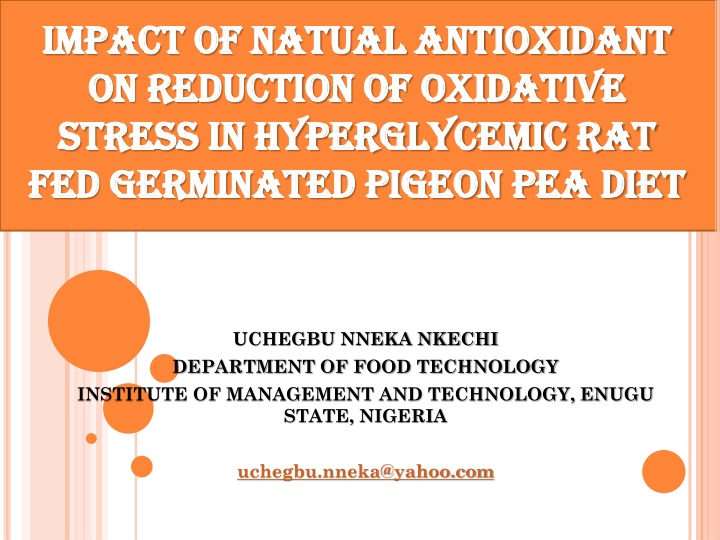

![READ [PDF] Dash diet Cookbook for beginners: 365 days of simple, healthy, low-s](/thumb/2057/read-pdf-dash-diet-cookbook-for-beginners-365-days-of-simple-healthy-low-s.jpg)
